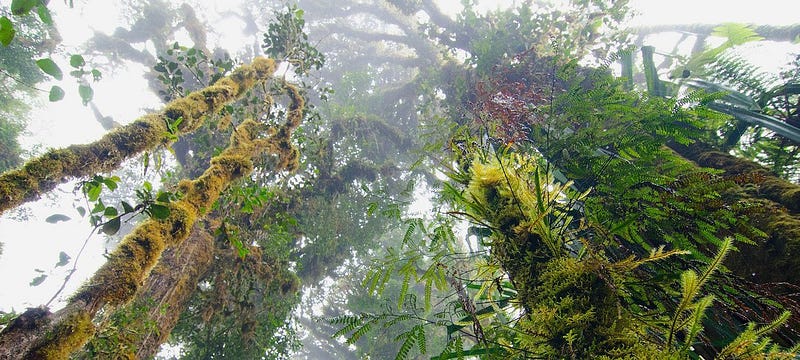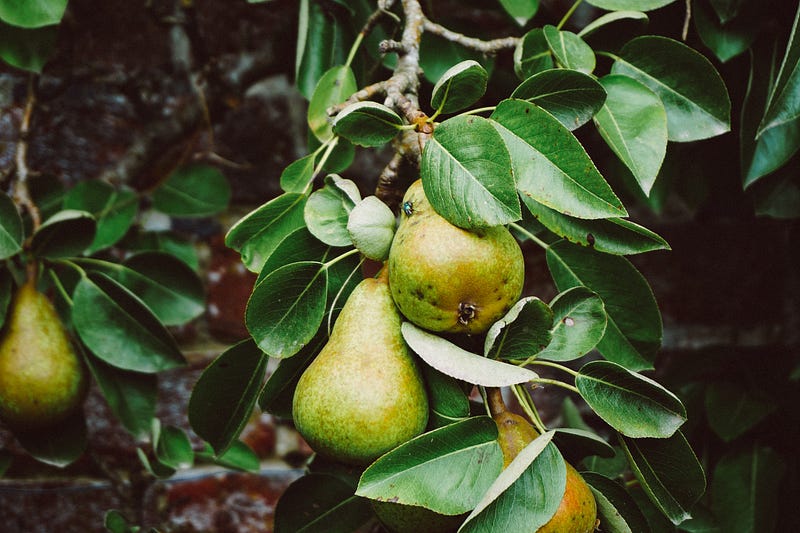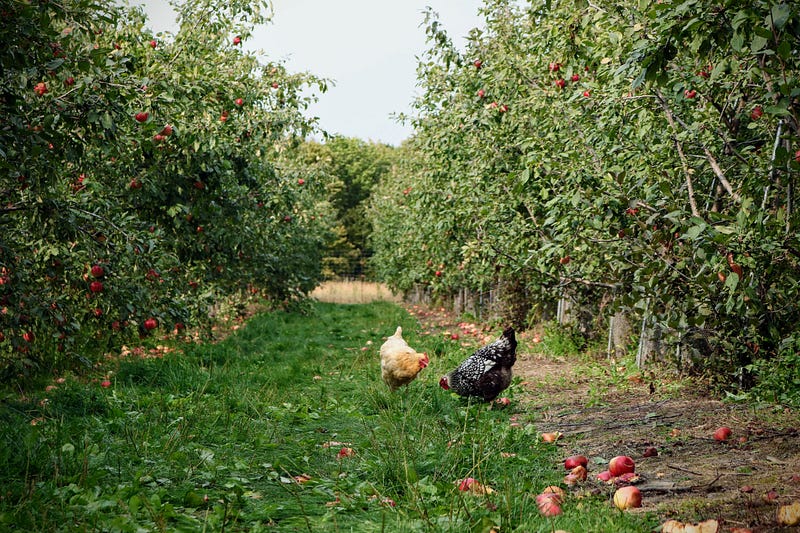Planting and protecting forests can slow climate collapse

Nature has tremendous healing power, and if we work with Her, we could still survive climate chaos and perhaps create a more beautiful world. Nature heals through the life force, which takes 1000 forms, but three of them stand out for climate: soil, trees, and water. I wrote about soil and farming here, and I’ll write about water next time. This piece is about our big sisters, the trees.
Our tall relatives can control climate, absorb carbon, bring rain, and create living space for thousands of other species. Although wood is a wonderful resource, trees are not just building materials with roots. They’re alive and active, constantly moving water, gases, and nutrients around to where they’re needed. They can transform environments, especially if we help them.
In The Hidden Life of Trees, German forest scientist Peter Wohlleben explains how forests make soil fertile, maintain the water cycle, and cool the ground with shade. In natural forests, life keeps getting more intricate and beautiful year after year. Their profusion of species and ecological niches keep each other strong and make surrounding land more productive.

Wohlleben says that lumber companies don’t understand what trees really are, a community of living things. They replace natural forests with tree plantations of pines grown in rows. That practice produces much lumber, but doesn’t provide the other benefits trees can bring. Natural forests bring nitrogen into the soil, stimulate the growth of fungi that enrich soil, and hold it from washing away in the rain or blowing away in the wind.
Land dries out and the world heats up when forests are cut down. Dried out soil won’t produce much food, and while enriching soil with regenerative agriculture is vital, you can’t grow much long term without trees. Along with the gradual loss of topsoil, tree loss can cause environmental disasters such as mudslides that wipe out whole villages, as is happening now in the Philippines.
Three ways trees cool the Earth
● Trees bring Water — According to Wohlleben, rain is evaporated sea water, and without trees, wouldn’t fall more than 200 miles from the sea. Trees soak up the rain and transpire it back into the air through their leaves, where it can blow in another 200 miles, and so on. Without forests, the interior of continents would all be savannas, prairies or deserts, as you can see in central Asia, Africa, and North America.
● Trees capture Carbon — Forest sequester huge amount of carbon. They absorb carbon dioxide from the air, combine it with water through photosynthesis, and link the resulting sugars into long chains to make wood. As long as they’re alive, or as long as their wood becomes housing or furniture, that CO2 is out of the atmosphere.
They also enrich soil, another place Nature stores carbon. Scientists estimate that soil could store up to 4 billion tons of carbon a year with best practices, and trees are vital to those processes.
● Trees give Shade — Tree crowns shadow and cool the Earth under them. Animals and other plants can live there when the surrounding land gets uncomfortably hot.
That is how trees help farms and start the reclamation of deserts, such as the Loess Plateau in China. There, over a million Chinese people under government scientists’ direction planted trees and shrubs on the hills, terraced the hillsides to keep soil from sliding, and dug lakes and canals at the bottom to hold water.
If the right trees are planted in the right places, the trees hold the soil and bring rain; their leaves and fallen bark turn dry dirt into living soil (with the help of fungi,) and can make wastelands back into fertile land.
Farmers in Niger have turned near-desert into farmland by caring for trees. Instead of removing saplings to plant crops, they planted around the trees and protected them from animals. The trees create soil and shade the crops from the Sahel sun.
Which trees go where?
Not all trees are the same. Different trees grow well in different elevations, temperatures and rainfall.
Wohlleben writes that some tree species get along together better than others. Some even feed each other, while others compete fiercely and don’t like each other’s company. Left to their own devices, trees will find their niches over 100 years or so, but if people want them to move faster, we have to know what we’re doing.

Most people in populated areas find benefits in fruit trees. “Food forests” have become a topic in urban planning, growing bushels of fruit to feed people. In China, urban forests help create “sponge cities,” which soak up water and enrich surrounding farmland. Skillfully planted mixed forests can provide some timber, some food, habitat for animals, and a healthier climate.
A lot of people have written about planting woodlands or farm trees as part of permaculture. Information on tree-planting and care is all over the Web, easily found on a search engine such as Google. A group called TreeSisters recommends that people “connect with your local Native Plant Society, university, forest service/commission, nursery, arborist, or arboretum and ask for a list of local tree species that are appropriate for your planting purpose.”
One very special kind of tree is the mangrove, which grows near salty and brackish water where other trees can’t. In places as diverse as dry Saudi Arabia and wet Bangla Desh, mangroves create soil by desalinating water through their roots and breathing it into the air, where it comes down as rain. Mangroves apparently sequester a lot more carbon for a longer time than almost any other species. Organizations like Sea-Trees and Blue Planet Ecosystem do large scale mangrove planting which we can support or join.
Ironically, the response of capitalist science to mangrove desalinization has not been “Plant mangroves.” It has been, ‘Figure out how mangroves do it and design machines to do the same thing.’ Head-shaking, but this response could in fact be useful in some places, because mangroves won’t grow everywhere. Perhaps technology can desalinate where mangroves don’t grow.
I have come to believe we can’t be narrow-minded about solutions. Maybe we have to let people be who they are, and figure out how they can serve, as with different species of trees. Science has to work together with traditional wisdom and Nature’s power. Science can hurt or help, and so can rich people.
Nature could not have healed the Loess Plateau without human help. We had damaged it too badly; it needed help from the local goatherds, the Communist Party, the World Bank and a million other people. Capitalist economics has the power to screw up the best natural solutions, but maybe their scientists and engineers, can learn to serve Nature as well as they have served bankers.
Most of us probably aren’t up to starting new forests, but governments can, and many nonprofit organizations are trying. You can find groups like Plant-for-the-Planet, Trees for the Future, and a dozen others on a Web search. Join with one you like (one that works with indigenous people) or support them with donations. Planting one tree at a time and taking care of it helps, too.

Protecting the forests we have
Planting new forests is great, but it’s hard to keep up with the pace of deforestation. According to the United Nations, about 10 million hectares (24 million acres) of forest are cut down or burned in an average year. About half that much gets planted, but the lost old growth is an irreplaceable treasure. Without it, forest will turn to grassland, or at best, not-so-productive farmland. Millions of species will go extinct.
Many organizations try to stop the destruction. We can support groups like Cultural Survival and Rainforest Action Network. Empowering Indigenous people is key. People who consider themselves part of the forest will usually fight harder and more effectively than people from faraway cities.
I don’t want to kid anyone. Trees can’t overcome chemical pollution, fossil fuel burning, mining, deforestation, wars, and world-paving by themselves. We can’t water a tree and go on with life as usual. We need a mass movement of people recommitting to the land, learning from indigenous ways of life. We need to force corporations and governments to cooperate or disappear. We need to make Earth the highest priority in all we do. Money could serve Earth by paying people to plant and grow, as they have in Niger, China, Uganda and other places.
All this sounds extraordinarily difficult, but my point is that it is possible. If we value Nature first in all our decisions, trees will grow back and help the rest of us survive. For me, prioritizing Nature and committing to trees, soil, and/or water in our work is the most important thing we can do with our lives. We have to stand up for our tall Sisters. Just being with them will at least make us healthier, so why not join them and fight for them?
— — —
Thanks for reading! Please comment, share, or steal. Follow me on Twitter, on Facebook or on Medium.com. Hire me for freelancing, editing, or tutoring on Linked In
